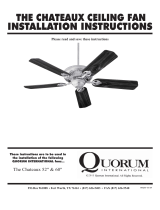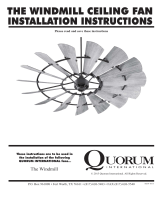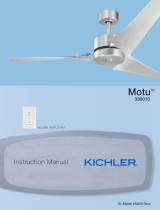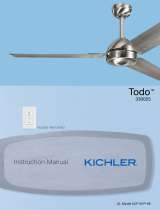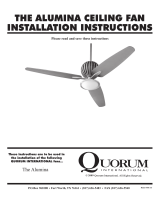Page is loading ...

ME013-01 r090115
Industrial
• Operation
• Assembly
• Installation
Owner’s Manual
Ceiling Fan
Revolutions
1 Piece
220V ~ 50/60Hz
12.3 lbs (5.6 kg)
Product:
Trademark:
Quantity:
Electrical Rating:
Weight ±2 lbs:

ME013-01 09/01/2015
2
You have chosen the best. Your new Revolutions ceiling fan will provide you
with many years of comfort and satisfaction.
Congratulations!
Read and Save These Instructions
This product conforms to UL Standard 507.
WARNINGS
w.1 - To reduce the risk of personal injury, attach the fan directly to the support
structure of the building according to these instructions, and use only the hardware
supplied.
w.2 - To avoid possible electrical shock, before installing or servicing your fan,
disconnect the power by turning off the circuit breakers to the outlet box and
associated wall switch location. If you cannot lock the circuit breakers in the off
position, securely fasten a prominent warning device, such as a tag, to the service
panel.
w.3 - To reduce the risk of fire, electrical shock, or motor damage, use only Hunter
Speed Controls.
w.4 - To reduce the risk of personal injury, do not bend the blade brackets when installing
the blade brackets, balancing the blades, or cleaning the fan. Do not insert foreign
objects in between rotating fan blades.
c.1 - All wiring must be in accordance with national and local electrical codes ANSI/
NFPA 70. If you are unfamiliar with wiring, use a qualified electrician.
c.2 - Use only Hunter replacement parts.
CAUTIONS

ME013-01 09/01/2015
3
1. Unpack your fan and check the contents. Do not discard the box. If warranty replacement or repair
is ever necessary, the fan should be returned in its original packaging. Remove all parts and hard-
ware. Do not lay the motor housing on its side; the decorative casing may shift.
2. Examine all parts. You should have the following:
Tools and Materials Required
1. Mounting Bracket
2. Canopy
3. Downrod
4. Motor
5. Blades
6. Wall Control
7. Parts Pack Containing:
a. Mounting bracket hardware (extra screw
and washer, and wire nuts)
b. Noise isolators
Note: Some Revolutions fan models will have slightly different parts than shown here,
depending upon the model. Basic installation procedures are similar for all fan models.
• Phillips screw driver
• Flat Head screw driver
• Adjustable pliers or wrench
• Step Ladder
• Wire Cutter
• Electrical tape
Unpacking the Fan
2
1
3
4
5
6
7
1
2
3
0
1. Disassemble the hanger ball from the downrod by removing
the set screw and lock pin at the end of the downrod. Slide the
hanger ball down the downrod and remove the support pin and
green ground screw and wire.
2. Place the green ground wire ring terminal on the ground screw
to the new downrod and tighten.
3&4.Place the hang ball on the new downrod and insert the support
pin through the holes at the top ofthe downrod. Slide the hang
ball up the downrod, putting the support pin into the slots of the
hang ball.
5. Insert the set screw through the hang ball into the downrod and
tighten.
Assembling a Longer Downrod
Ball
Screw
Downrod
Washer
Ground Wire
Support Pin

ME013-01 09/01/2015
4
Assessing the Installation Location
,8 Meters
from blade tip
to nearest wall
or obstruction
3,05 Meters
from bottom
edge of blade to
the oor
CAUTION
To reduce the risk of injury to
persons, install fan so that the blade
is at least 3,05 m above the floor.
OFF
Turn Power
1. To avoid possible electrical shock, be sure electricity is turned off at the main
power panel before wiring. AII wiring must be in accordance with national
and local electrical codes, and the ceiling fan must be grounded as a
precaution against possible electrical shock.
2. Use mounting hardware.
3. The mounting bracket should be installed to the wooden structure of the
ceiling joist with the two provided wood screws (Fig.1).
Install Mounting Bracket
CAUTION: Electrical box must be wired
to NOM general use wall switch. To reduce
the risk of injury, turn off power at wall
switch or main fuse or circuit breaker before
attempting installation or servicing.
WARNING: To avoid re or shock,
follow all wiring instructions carefully.
Any electrical work not described in these
instructions should be done or approved by
a licensed electrician.
Fig. 1
Electrical Outlet Box
Rubber Washer
Mounting Bracket
Flat Washer
Wood Screw

ME013-01 09/01/2015
5
Mounting the Fan
Wiring the Fan
WARNING: The fan must be hung with at least 3,05 m of clearance from oor to blades.
1. Install ball into hanger bracket opening. The tab opposite of the hanger bracket opening should t
in slot on ball (Fig. 2).
2. Make wire connections (refer to section titled “Wiring the Fan”).
3. Slide the canopy up and fasten to the hanger bracket with the four screws provided.
WARNING: To avoid damaging the blade arms and blades, do not install either until the fan
is fastened to the ceiling. To avoid motor shift, handle fan by downrod or switch housing only.
1. Three wires coming from the top of the fan (Fig. 3):
Black: “Hot” Power for the fan
White: “Common” For the fan and light
Green with yellow stripe: Ground Wire
2. The white wire from the fan should be connected to the white wire in the ceiling, using a wire nut to
make the connection.
3. The black wire from the fan should be connected to the black wire in the ceiling, using a wire nut to
make the connection.
4. The green with yellow stripe wire from the fan should be connected to the ground wire in the ceiling,
using a wire nut to make the connection.
5. Tuck your completed wiring back up into the electrical box.
Note: To connect the wires, hold the bare metal leads together and place a wire connector
over them, then twist clockwise until tight.
From Bracket
(Grounding)
Green/Yellow
Stripe
Green
From Fan
From Ceiling
White
Black
(Grounded)
(Ungrounded)
From Fan
From Ceiling
Fig. 2
Fig. 3

ME013-01 09/01/2015
6
Installing the Blades
Installing the Wall Control
1. Remove the blade iron screws from the fan. Save the screws
2. Attach blades to the fan using the cloth noise isolators (1) and the blade iron screws (2).
3. Tighten screws securely (Fig.4).
1. To install the wall control, you must rst remove the faceplate and switch assembly from the existing
wall control, if you have one. Save the screws from the faceplate to use for the new one. Caution: A
power disconnect switch should be installed in conjunction with the wall control (Fig. 5).
2. Connect the green with yellow stripe grounding wire to the grounding wire coming from the wall
control outlet box (Fig. 6).
3. Connect the black wire marked “TO MOTOR L” to the wire coming from the wall control outlet box that
goes to the fan (Fig. 6).
4. Connect the black wire marked “AC IN L” to the the LIVE wire that goes to the wall control (Fig. 6).
5. Carefully push the wires and the wall control into the outlet box. Install the screws through the wall
control faceplate and wall control and into the outlet box (Fig. 7).
1
2
3
0
“To Motor L” (Black)
“AC IN L” (Black)
To Fan
LIVE IN
From
Included
Wall
Control
From
Outlet Box
1
2
Fig. 4
Fig. 5
Fig. 6
Fig. 7
Grounding
Grounding
1
2
3
0

ME013-01 09/01/2015
7
Operating the Fan
Reversing the Fan
ON
Turn Power
1. Turn power on at the the main fuse box.
2. Turn on the wall switch.
The wall control had 3 speeds:
3 - Low
2 - Medium
1 - High
0 - Off
1
2
3
0
In warm weather, ceiling fans work best by
blowing air downward (counterclockwise)
providing the room with a cool breeze.
In cool weather, set your fan to draw
air upward (clockwise) to distribute the
warmer air trapped at the ceiling without
causing a draft.
Turn the fan off and let the blades stop before changing the direction of the air flow. Engage the reverse
switch to change the blade direction.

ME013-01 09/01/2015
8
Troubleshooting
Maintenance
FAN IS NOISY
1. Use of standard light rheostat or continuously variable fan speed wall control will always cause har-
monic distortions or a huming noise. Many fan motors do not work quietly with solid state variable
controls. If a quiet wall control is desired use only 3-speed NOM approved wall controls.
2. Always allow a few days of ‘break in’ time for any new fan at medium or high speed. Try to diagnose
the exact location of the noise by listening carefully from several sides (Blades, Motor, Light Kit, etc...).
3. Make sure all screws in the fan assembly are tight and properly threaded. If not, back out and retight-
en. Tighten these screws at least once a year because they may loosen slowly over time and cause a
clicking noise.
4. Make sure mounting bracket is installed snugly to junction box.
5. Make sure wire nuts in switch housing or canopy are not rattling against each other or against wall of
housing. Wrap with electrical tape if necessary.
6. Make sure the canopy is not touching the ceiling.
7. Make sure that the screws fastening blade arm to motor are tight.
FAN SHAKES OR WOBBLES
1. A small amount of movement is considered acceptable and should not be considered a defect.
2. Make sure mounting bracket is tight at junction box/ceiling with no movement at all. Tighten screws if
necessary.
3. Make sure all screws holding the blades to the blade arm and blade arm to motor are tight. Make sure
light kit/glass screws are tight.
4. Some fan movement is normal. However, interchanging an adjacent (side-by-side) blade pair may
redistribute the weight and result in smooth operation.
5. Most fan wobble problems are caused when blade levels are unequal. Check this level by selecting a
point on the ceiling above the tip of one of the blades. Measure this distance. Measurements deviation
should always be within1/8”. Rotate the fan until the next blade is positioned for measurement. Repeat
for each blade.
FAN WILL NOT START:
1. Check all fuses or circuit breakers. Replace if missing.
2. Turn off electrical power and check all wire connections to fan and in the wall control.
FAN TURNS BUT DOES NOT MOVE MUCH AIR:
1. The fan may be running in reverse, so air is directed upward.
2. The room may contain items that obstruct the air ow.
3. The fan may be too small for size of the room.
1. The fan’s natural movements may cause some connections to loosen. A clicking or rattling noise is a
certain sign of loosening screws. Check the support connections, brackets, and blade attachments
twice a year, and tighten all screws as necessary. Make sure all screws attaching the glass to the tter
on the light kit are nger tight. Do not use a screw driver or pliers to tighten glass screws.
2. Clean your fan periodically. Use only a cloth dampened with a mild detergent solution. Never use
solvents. Dust with a soft cloth or brush. Metal nishes are nished with a lacquer to prevent tarnishing
3. You will never need to oil your fan. Its permanently sealed bearings will provide silent, trouble free
operation for many years.
4. Make sure the power is turned off at the main fuse or circuit panel before you attempt any repairs.
/






